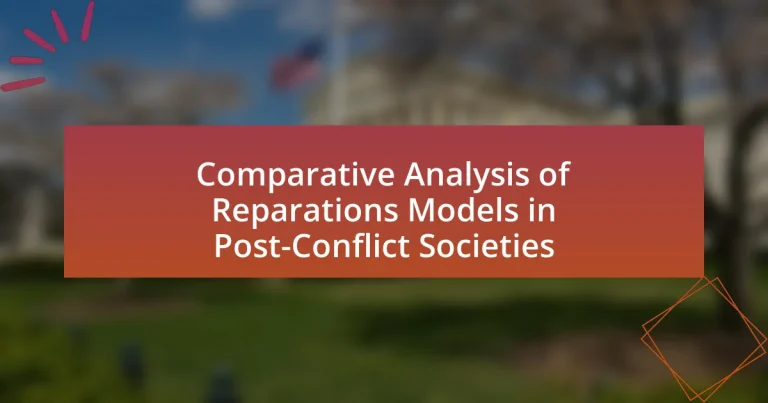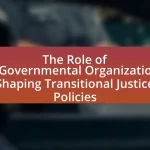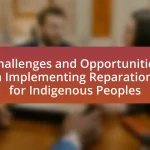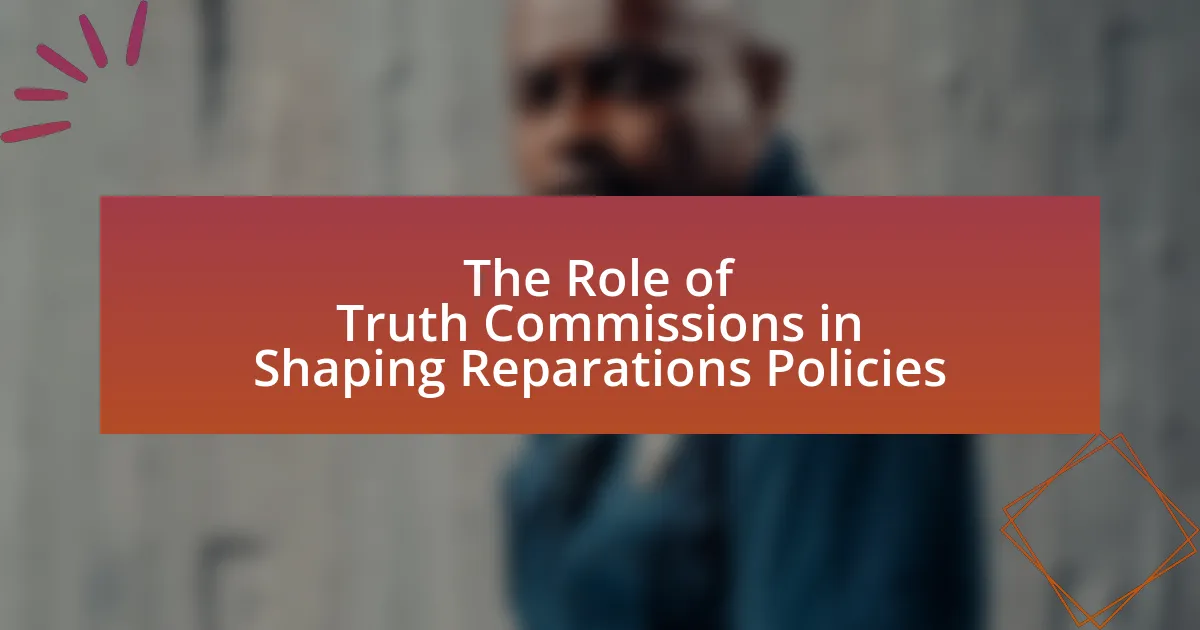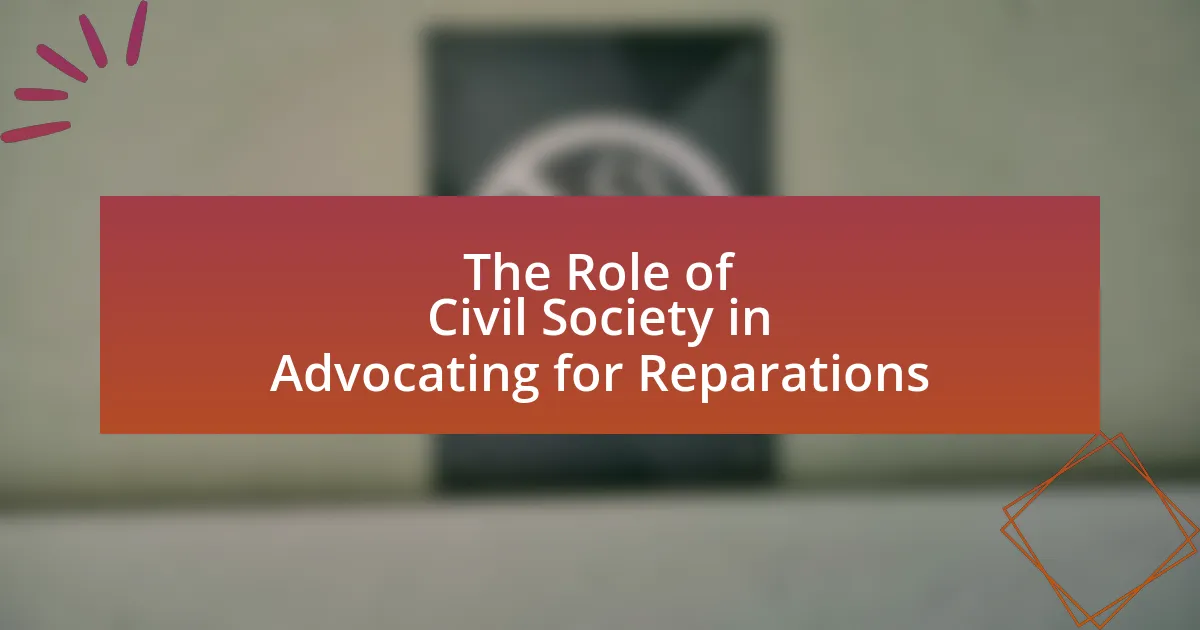The article provides a comparative analysis of reparations models in post-conflict societies, focusing on frameworks designed to address injustices experienced during periods of conflict. It examines various types of reparations, including financial compensation, restitution, and symbolic measures, while highlighting key components such as acknowledgment of harm and guarantees of non-repetition. The article also explores how different cultural, historical, and political contexts influence the effectiveness of these models, the challenges faced in their implementation, and best practices for designing reparations initiatives. Through case studies, it illustrates the importance of community engagement and tailored approaches in fostering healing and social justice.

What are Reparations Models in Post-Conflict Societies?
Reparations models in post-conflict societies are frameworks designed to address the injustices and harms suffered by individuals and communities during periods of conflict. These models typically include financial compensation, restitution of property, and symbolic measures such as public apologies or memorialization efforts. For instance, the Truth and Reconciliation Commission in South Africa implemented reparations that included both monetary compensation and community development projects aimed at healing and rebuilding trust. Such models are essential for promoting social justice, reconciliation, and long-term stability in societies recovering from conflict, as evidenced by their role in addressing grievances and fostering a sense of closure among affected populations.
How do different reparations models function in various contexts?
Different reparations models function in various contexts by addressing the specific historical injustices and socio-economic conditions of affected communities. For instance, in South Africa, the Truth and Reconciliation Commission implemented a model focused on restorative justice, which emphasized acknowledgment and healing over financial compensation, reflecting the country’s need for national unity post-apartheid. Conversely, in Germany, reparations for Holocaust survivors involved direct financial payments and social services, recognizing the unique and severe nature of the injustices faced. These models demonstrate that reparations must be tailored to the cultural, historical, and political contexts of the societies they aim to serve, ensuring that they effectively address the needs and rights of victims while promoting societal healing and justice.
What are the key components of reparations models?
The key components of reparations models include acknowledgment of harm, restitution, compensation, rehabilitation, and guarantees of non-repetition. Acknowledgment of harm involves recognizing the injustices suffered by victims, which is essential for healing and reconciliation. Restitution refers to the return of property or rights taken from victims, while compensation provides financial or material support to address the losses incurred. Rehabilitation focuses on restoring the dignity and well-being of victims through services such as healthcare and psychological support. Finally, guarantees of non-repetition ensure that measures are put in place to prevent future violations, thereby fostering a more just society. These components are critical in creating effective reparations frameworks that address the needs of affected communities in post-conflict settings.
How do these components vary across different societies?
Reparations models in post-conflict societies vary significantly based on cultural, historical, and political contexts. For instance, in South Africa, the Truth and Reconciliation Commission emphasized restorative justice and public acknowledgment of past atrocities, while in Germany, reparations focused on financial compensation for Holocaust survivors, reflecting a different historical context and societal values. Additionally, in Rwanda, the Gacaca courts incorporated community participation to address the genocide’s aftermath, showcasing a unique approach tailored to local needs. These variations illustrate how societal components such as historical grievances, cultural values, and political structures shape the reparations process in distinct ways.
Why are reparations important in post-conflict societies?
Reparations are important in post-conflict societies because they serve to acknowledge and address the injustices suffered by victims, fostering healing and reconciliation. By providing financial compensation, restitution of property, or social services, reparations help restore dignity to individuals and communities affected by conflict. Historical examples, such as the reparations paid to Holocaust survivors, demonstrate that such measures can facilitate societal healing and contribute to long-term stability. Furthermore, research indicates that reparations can reduce the likelihood of future violence by promoting social cohesion and trust in institutions, as seen in the post-apartheid reparations in South Africa.
What role do reparations play in healing and reconciliation?
Reparations play a crucial role in healing and reconciliation by addressing historical injustices and fostering trust between affected communities and the state. They serve as a formal acknowledgment of past wrongs, which is essential for victims to feel validated and recognized. For instance, in South Africa, the Truth and Reconciliation Commission emphasized reparations as a means to promote national unity and healing after apartheid, demonstrating that financial compensation and symbolic gestures can help rebuild relationships and restore dignity. Studies show that effective reparations contribute to reducing social tensions and can lead to more stable post-conflict societies, as seen in countries like Germany after World War II, where reparations to Holocaust survivors facilitated societal healing and integration.
How can reparations contribute to social justice and equity?
Reparations can contribute to social justice and equity by addressing historical injustices and providing compensation to marginalized communities. By acknowledging past wrongs, such as slavery or colonialism, reparations aim to rectify systemic inequalities that persist today. For instance, the implementation of reparations in South Africa post-apartheid included financial compensation and land restitution, which helped to reduce economic disparities and promote social cohesion. Studies indicate that reparations can lead to improved social outcomes, as seen in the case of Germany’s reparations to Holocaust survivors, which facilitated their integration into society and improved their quality of life. Thus, reparations serve as a mechanism for fostering equity and promoting healing in societies affected by historical injustices.
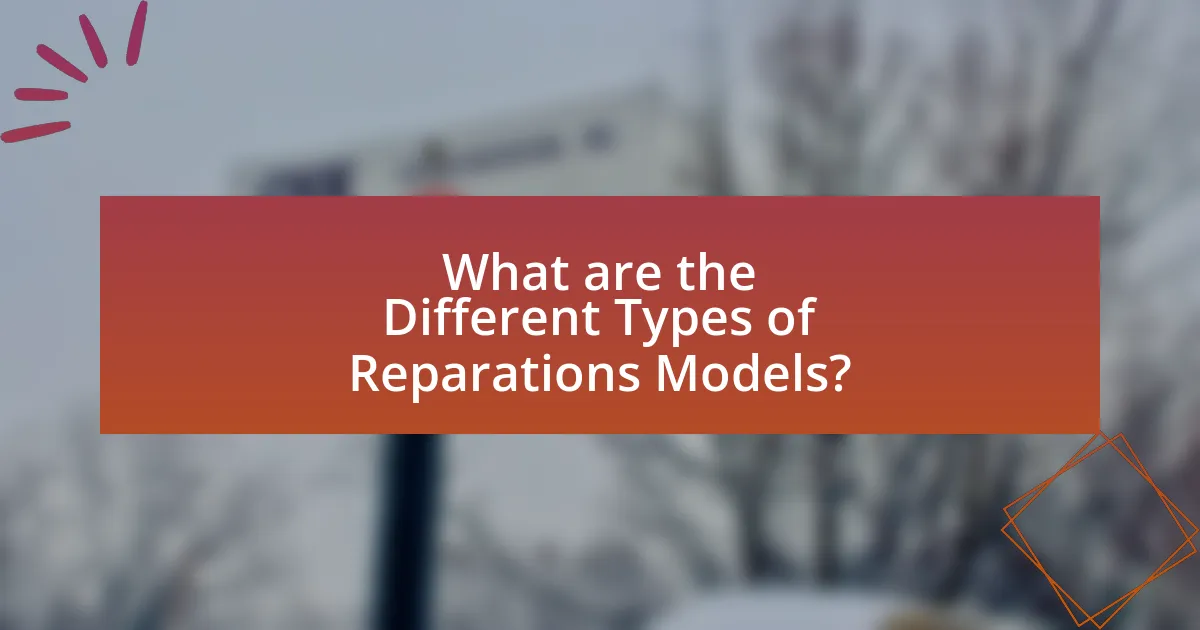
What are the Different Types of Reparations Models?
The different types of reparations models include individual compensation, collective reparations, symbolic reparations, and institutional reforms. Individual compensation provides financial or material support to specific victims, while collective reparations address the needs of entire communities affected by conflict. Symbolic reparations involve public acknowledgment of harm and may include memorials or apologies, and institutional reforms aim to change policies or practices that contributed to the injustices. These models are utilized in various post-conflict societies to address historical grievances and promote healing. For example, South Africa’s Truth and Reconciliation Commission implemented a combination of individual compensation and symbolic reparations to address apartheid-era injustices.
What are the primary categories of reparations models?
The primary categories of reparations models include financial compensation, restitution of property, rehabilitation services, and symbolic measures. Financial compensation involves direct payments to victims or their families, while restitution of property refers to the return of land or assets taken during conflicts. Rehabilitation services focus on providing medical, psychological, and social support to affected individuals. Symbolic measures may include public apologies, memorials, or acknowledgment of past injustices, which serve to validate the experiences of victims and promote healing. These categories are essential for addressing the diverse needs of individuals and communities impacted by conflict, as highlighted in various studies on post-conflict reparations.
How do financial reparations differ from symbolic reparations?
Financial reparations provide direct monetary compensation to individuals or communities affected by injustices, while symbolic reparations involve actions that acknowledge past wrongs without financial compensation, such as public apologies or memorials. Financial reparations aim to restore economic stability and address material losses, evidenced by programs like the U.S. government’s payments to Japanese Americans interned during World War II, which totaled $1.6 billion. In contrast, symbolic reparations, such as South Africa’s Truth and Reconciliation Commission, focus on healing and recognition of suffering, emphasizing the importance of memory and acknowledgment over financial restitution.
What are the implications of community-based reparations?
Community-based reparations can lead to enhanced social cohesion and empowerment within affected communities. By addressing historical injustices at a local level, these reparations foster a sense of agency among community members, allowing them to participate actively in the healing process. Evidence from various post-conflict societies, such as South Africa and Rwanda, indicates that community-driven initiatives can effectively restore trust and promote reconciliation among diverse groups. Furthermore, community-based reparations often prioritize collective benefits, such as infrastructure development and educational opportunities, which can contribute to long-term economic stability and resilience. This approach not only acknowledges the collective suffering of communities but also facilitates a shared path toward recovery and growth.
How do cultural factors influence reparations models?
Cultural factors significantly influence reparations models by shaping the values, beliefs, and historical narratives of affected communities. These factors determine how societies perceive justice, accountability, and the legitimacy of reparations, which can vary widely across different cultural contexts. For instance, in societies with a strong emphasis on collective memory and historical grievances, such as in South Africa post-apartheid, reparations models often incorporate public acknowledgment and memorialization as essential components. This approach reflects the cultural importance of recognition and healing in those communities. Conversely, in cultures where individualism prevails, reparations may focus more on financial compensation or direct benefits to individuals rather than collective measures. Research indicates that cultural understandings of harm and restoration directly impact the acceptance and effectiveness of reparations, as seen in various post-conflict societies where cultural narratives shape the expectations and demands for reparative justice.
What cultural considerations must be taken into account in reparations?
Cultural considerations in reparations include recognizing historical injustices, understanding the specific needs and values of affected communities, and ensuring that reparations align with cultural practices and beliefs. For instance, reparations must address the collective memory and identity of marginalized groups, as seen in the case of Indigenous peoples in Canada, where reparations are tied to land rights and cultural preservation. Additionally, reparations should involve community participation to ensure that the solutions are culturally relevant and accepted, as demonstrated by the Truth and Reconciliation Commission in South Africa, which emphasized the importance of cultural acknowledgment in healing processes.
How do societal values shape the effectiveness of reparations models?
Societal values significantly shape the effectiveness of reparations models by influencing public support, policy implementation, and the perceived legitimacy of reparations. For instance, in societies where values emphasize justice and equality, reparations are more likely to be viewed as a moral imperative, leading to stronger advocacy and political will for their implementation. Conversely, in societies where values prioritize individualism or economic growth over collective historical injustices, reparations may face resistance, undermining their effectiveness. Historical examples, such as South Africa’s Truth and Reconciliation Commission, illustrate how societal values around forgiveness and unity facilitated the acceptance of reparations, while in contrast, the lack of such values in other contexts has led to ineffective or incomplete reparations efforts.

What are the Challenges in Implementing Reparations Models?
The challenges in implementing reparations models include legal, financial, and social obstacles. Legal challenges arise from the complexity of establishing liability and the need for legislative frameworks to support reparations. Financial challenges involve securing adequate funding and resources to implement reparations effectively, as seen in cases like South Africa’s Truth and Reconciliation Commission, which faced budget constraints. Social challenges include public opposition and differing opinions on the legitimacy and fairness of reparations, as evidenced by debates in the United States regarding reparations for slavery. These factors complicate the design and execution of reparations programs, often leading to incomplete or ineffective outcomes.
What obstacles do post-conflict societies face in enacting reparations?
Post-conflict societies face significant obstacles in enacting reparations, primarily due to political instability, lack of resources, and societal divisions. Political instability often leads to changes in leadership and priorities, making it difficult to establish a consistent reparations framework. For instance, in countries like Rwanda, the aftermath of the genocide created a fragmented political landscape that complicated the implementation of reparative measures. Additionally, limited financial resources hinder the ability to provide adequate compensation or support to victims, as seen in the case of Bosnia and Herzegovina, where economic constraints have delayed reparations programs. Societal divisions, stemming from historical grievances and ethnic tensions, further complicate the process, as seen in South Africa, where the Truth and Reconciliation Commission faced challenges in gaining widespread acceptance of its findings and recommendations. These factors collectively impede the effective enactment of reparations in post-conflict contexts.
How do political dynamics affect the implementation of reparations?
Political dynamics significantly influence the implementation of reparations by shaping legislative priorities, public opinion, and the political will of leaders. For instance, in countries where political factions are divided on the issue of reparations, such as in South Africa, the lack of consensus can delay or obstruct the establishment of reparative measures. Additionally, political leaders may prioritize reparations differently based on their electoral agendas, as seen in the United States, where discussions around reparations for African Americans have fluctuated with changing administrations and their respective party platforms. Furthermore, public sentiment, often swayed by political narratives, can either bolster or hinder reparations efforts; for example, increased advocacy and awareness can lead to stronger political support, while opposition can result in legislative stagnation.
What are the common public perceptions regarding reparations?
Common public perceptions regarding reparations include a belief that they are necessary for addressing historical injustices and promoting social equity. Many individuals view reparations as a means to acknowledge and rectify the harm caused by systemic discrimination, particularly in contexts such as slavery and colonialism. Surveys indicate that a significant portion of the population supports reparations, with studies showing that around 60% of Americans believe that the government should provide reparations to African Americans for slavery. Additionally, public opinion often reflects a divide along racial and political lines, with minority groups generally more supportive of reparations compared to their white counterparts. This perception is reinforced by historical precedents, such as the reparations paid to Japanese Americans interned during World War II, which are often cited as a successful model for addressing past wrongs.
How can successful reparations models be evaluated?
Successful reparations models can be evaluated through a combination of criteria including effectiveness, equity, and sustainability. Effectiveness is measured by the extent to which reparations address the harms suffered by affected communities, such as financial compensation, land restitution, or public acknowledgment of injustices. Equity involves assessing whether reparations are distributed fairly among different groups, ensuring that marginalized populations receive adequate support. Sustainability examines the long-term impact of reparations on social cohesion and economic stability, determining if the measures lead to lasting improvements in the lives of beneficiaries. For instance, the reparations program in South Africa post-apartheid has been analyzed for its effectiveness in promoting reconciliation and addressing historical injustices, providing a concrete example of how these criteria can be applied in evaluating reparations models.
What metrics can be used to assess the effectiveness of reparations?
Metrics to assess the effectiveness of reparations include economic indicators, social cohesion measures, and psychological well-being assessments. Economic indicators can be evaluated through changes in income levels, employment rates, and access to education among affected populations, demonstrating tangible improvements in living standards. Social cohesion measures can be assessed by analyzing community integration, trust levels among different groups, and participation in civic activities, which reflect the restoration of relationships and societal stability. Psychological well-being assessments can be conducted through surveys measuring trauma recovery, mental health status, and overall life satisfaction, indicating the reparations’ impact on individual and collective healing. These metrics provide a comprehensive framework for evaluating the success of reparations in addressing historical injustices and fostering recovery in post-conflict societies.
How do case studies inform best practices in reparations implementation?
Case studies inform best practices in reparations implementation by providing empirical evidence of successful strategies and outcomes in various contexts. For instance, the reparations program in South Africa post-apartheid highlighted the importance of public acknowledgment and truth-telling as essential components for healing and reconciliation. This case demonstrated that reparations should not only focus on financial compensation but also include symbolic measures that address historical injustices. Additionally, the experience of Germany in compensating Holocaust survivors illustrates the effectiveness of structured, long-term financial support combined with community engagement, which can enhance the legitimacy and acceptance of reparations. These examples underscore that tailored approaches, informed by specific historical and cultural contexts, are crucial for effective reparations implementation.
What are the Best Practices for Designing Reparations Models?
The best practices for designing reparations models include ensuring inclusivity, establishing clear eligibility criteria, and providing a mix of financial and non-financial reparations. Inclusivity ensures that all affected groups are represented, which is crucial for legitimacy and acceptance. Clear eligibility criteria help to define who qualifies for reparations, reducing ambiguity and potential disputes. A combination of financial reparations, such as direct payments, and non-financial reparations, like community development projects and public acknowledgment, addresses both individual and collective needs. Evidence from various post-conflict societies, such as South Africa’s Truth and Reconciliation Commission, demonstrates that these practices contribute to healing and rebuilding trust within communities.
How can stakeholder engagement enhance reparations models?
Stakeholder engagement can enhance reparations models by ensuring that the needs and perspectives of affected communities are integrated into the design and implementation of reparations programs. Engaging stakeholders, such as victims, community leaders, and civil society organizations, fosters a sense of ownership and accountability, which can lead to more effective and accepted reparations initiatives. For instance, the Truth and Reconciliation Commission in South Africa demonstrated that involving diverse stakeholders in discussions about reparations led to more comprehensive and culturally relevant solutions, ultimately increasing the legitimacy and impact of the reparations provided.
What lessons can be learned from successful reparations initiatives?
Successful reparations initiatives demonstrate the importance of community involvement and tailored approaches to address specific historical injustices. Engaging affected communities in the design and implementation of reparations fosters trust and ensures that the measures are relevant and effective. For instance, the Truth and Reconciliation Commission in South Africa highlighted the necessity of acknowledging victims’ experiences to promote healing and reconciliation. Additionally, successful initiatives often include a combination of financial compensation, social services, and public acknowledgment, as seen in Germany’s reparations to Holocaust survivors, which provided both monetary support and a formal recognition of suffering. These examples illustrate that comprehensive and inclusive strategies are crucial for the success of reparations initiatives in post-conflict societies.
